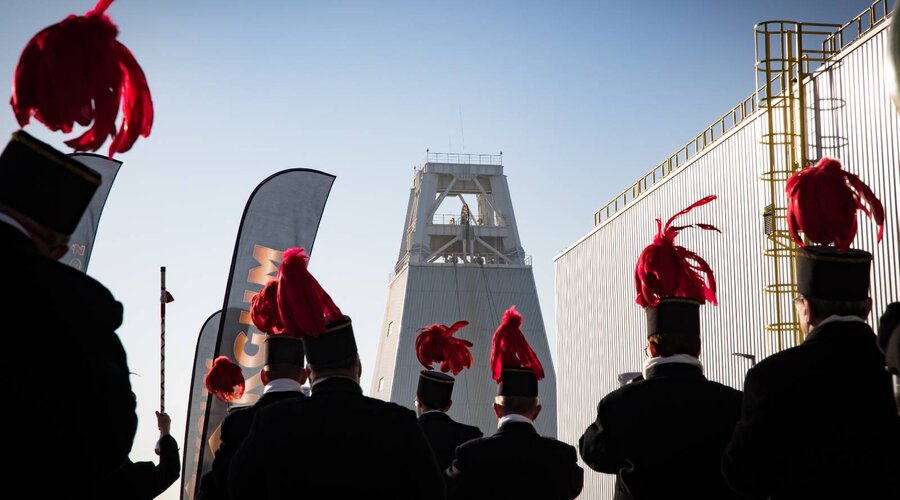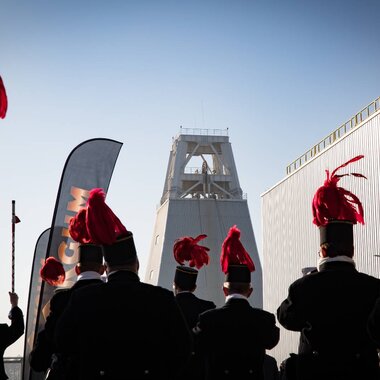Prof. Józef Zwierzycki is the patron of the KGHM shaft, the deepest mining excavation in Poland
An outstanding geologist, co-discoverer of copper deposits in Lower Silesia, became the patron of the GG-1 shaft in Kwielice, owned by KGHM. The construction of the shaft is one of the most important investments in the history of the copper giant. In June, a key connection for this project was made with the horizontal workings of ZG Rudna at a depth of 1,348 meters, which is the deepest one in Poland.
– The ceremony of naming the GG-1 shaft after Professor Józef Zwierzycki is a special event that combines the history of copper mining with great achievements in this field. The shaft will be a symbol of KGHM's continuity, innovation and commitment to the development of the mining industry. Let Józef Zwierzycki's passion continue to be an inspiration for new generations of miners. We are proud of the shaft, which is one of the most important investments in the history of the copper giant and the largest underground project in the non-ferrous metals industry in Europe. We are proud of the pioneers of Polska MIedź, to whom we owe the title of industry leader and thanks to whom we continue to develop – said during the event Mirosław Kidoń, vice-president of the KGHM management board for foreign assets, acting vice-president of KGHM for development.
– Contribution of prof. Józef Zwierzycki in building the power of KGHM is invaluable. His first research, determination and vision have made us a global leader in the mining industry. The copper company is constantly developing and looking for modern solutions for the production of metals, but it also maintains its traditions and heritage. Naming the GG-1 shaft after Professor Józef Zwierzycki symbolizes the perfect connection between the history and the future of Polska Miedź – added Jan Zimroz, general director for mining of KGHM Polska Miedź S.A.
– This is for KGHM Polska Miedź S.A. a very important moment - it is not only about the new shaft, but also honouring the name of the patron whose thought, knowledge and stubborn desire to drill holes in the places he indicated led to the decision by the then Central Office of Geology to commission exploration works by subordinate units. Years of work by many people, including conferences, conversations, letters, draft resolutions, and exhibitions in the Sejm of the Republic of Poland, have led to this symbolic act. For all of us, it is a deeply emotional moment. – said prof. Mariusz Orion Jędrysek from the Wrocław University.
The GG-1 shaft is of fundamental importance for the development of KGHM Polska Miedź S.A.. It will make it possible to open up new areas of the copper deposit and prolong the operation of the Polkowice-Sieroszowice and Rudna mines. The investment will improve ventilation and air conditioning while also shortening the crews' access routes to workplaces.
The shaft is ready for the installation of reinforcement and any necessary installations and devices within the target timeframe. A three-meter layer of concrete has been poured on the bottom (i.e. shaft sump). The two basic parameters of the GG-1 shaft are: depth - 1,348 meters, and the diameter in the light of the casing, which is 7.5 meters. It is an intake-air shaft that will be used to transport people and materials.
Prof. Józef Zwierzycki is a distinguished Polish geologist whose scientific research in 1951 led to the discovery of copper deposits in Lower Silesia. After the war, he co-founded the Institute of Geological Sciences at the University of Wrocław. His primary interest was the geology of the Recovered Territories. Zwierzycki was the first to propose the concept of copper deposits occurring in the Fore-Sudetic Monocline area. It transpired that this thesis was correct. In 1957, one of the largest deposits of copper ore in the world was discovered near Sieroszowice.
Construction of the GG-1 shaft, named after Professor Józef Zwierzycki, began in 2010. Two years later, KGHM began construction on the shaft tower, one of the tallest structures it has been built to date. It is 45.5 meters high and weighs 1,100 tons. The first bucket of excavated material left GG-1 on December 11, 2013. To build the first section of GG-1, PeBeKa employees used 466 cast iron tubing rings, which protected the shaft against flooding with water from the Tertiary and Triassic layers. To comprehensively protect GG-1 from the effects of water inflow, a modern so-called cascade drainage system was installed in the shaft. In the subsequent years, as the shaft was deepened, additional components of the drainage system were incorporated. A total of eight stations were built there, pumping water cascading from the bottom of the shaft to the surface.
Shaft GG-1 is the company's thirty-first shaft in the Copper Belt. However, work is already in progress to construct three additional shafts and other essential technical facilities as part of the Deposit Opening Program in new concession areas.










